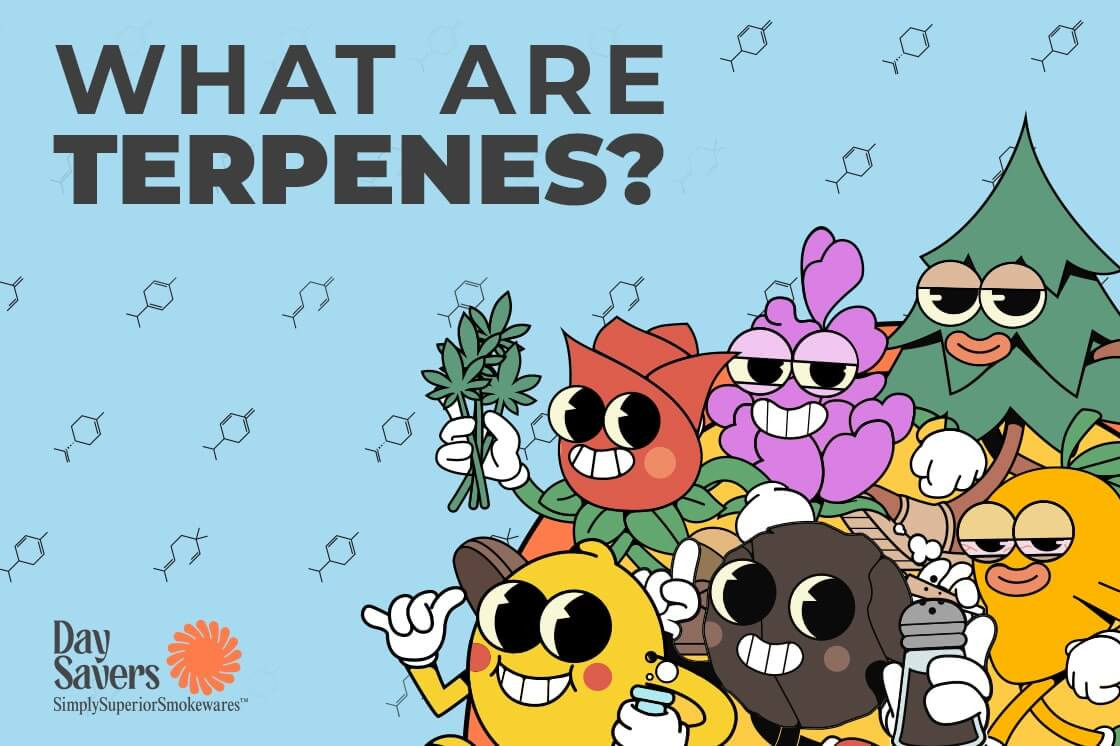What are Terpenes?
Posted by DaySavers Team on Apr 23rd 2024
From the earthy notes of OG Kush to the citrusy zest of Lemon Haze, cannabis terpenes offer a rich tapestry of scents and flavors that elevate the consumption experience to new heights. But terpenes are more than aromatic compounds—they are crucial to unlocking a world of therapeutic benefits and sensory delight.
Each of us has our cherished strains, whether for their potency or affordability. Yet, behind the allure of these favorites lies a crucial element: terpenes. These aromatic compounds are the essence of cannabis, shaping its signature scent and flavor profiles. Let's delve deeper into the significance of terpenes in cannabis.
What are Terpenes in Cannabis?

Terpenes are the aromatic compounds found in many plants, including cannabis. They are responsible for giving plants their distinctive scents and flavors, like those that distinguish various cannabis strains.
These compounds are abundant in different parts of the cannabis plant, including the flowers, leaves, and trichomes. With over 150 types identified in cannabis alone, terpenes contribute to the complex bouquet of scents enthusiasts appreciate, from the unmistakable aroma of Sour Diesel to the inviting scent of Cherry Pie.
But beyond their aromatic allure, terpenes play a multifaceted role, contributing to the therapeutic and mood-altering effects experienced by consumers, whether you prefer packing up a pre-roll or loading a bong.
Terpenes are naturally occurring chemical compounds found abundantly in cannabis and other plants. They serve essential functions within the plant, acting as a defense mechanism against predators and aiding in pollination by attracting insects. Terpenes are integral to the survival and propagation of plant species.
Moreover, terpenes, which are found in flowers, everyday herbs, spices and teas, have long been valued for their therapeutic properties. From the anti-inflammatory benefits of turmeric's curcumin to the antibacterial properties of thyme’s thymol, terpenes contribute to the medicinal qualities of various botanicals.
In cannabis, terpenes work synergistically with cannabinoids like THC and CBD to offer a range of therapeutic benefits, including pain relief, anxiety reduction and anti-inflammatory effects. This synergy, known as the “entourage effect,” highlights the importance of terpenes in enhancing the overall therapeutic potential of cannabis.
What Terpenes are Found in Cannabis?
Terpenes in cannabis share their presence with various other plants, contributing distinct flavor and scent profiles to favored buds. Within the cannabis market, enthusiasts generally covet four main terpenes above others for their unique characteristics: myrcene, limonene, pinene and linalool.
Myrcene

Frequently found in mangoes and hops, myrcene offers antioxidant properties, sedation and pain relief. It is also said to help extend the high created by THC. Described as dank, lush, and murky, its flavor and aroma profile stand out.
Limonene
Abundant in citrus fruits, limonene demonstrates anti-inflammatory properties and the potential for pain relief, focus, and energy. Noted for its citrusy, sharp, sour, and floral notes, it adds distinctiveness to cannabis strains.
Pinene
Discovered in conifer pine needles and sap, pinene touts anti-inflammatory, neurocognitive, and respiratory benefits. Its flavor and aroma profile recall pine and mint sensations.
Linalool
The terpene most associated with lavender, linalool presents potential effects such as pain relief, antioxidant properties and sedation. Its flavor and aroma profile are reminiscent of floral, sweet lavender.
Understanding these common terpenes in cannabis allows for insights into the potential effects and flavor profiles of different strains, empowering consumers to make more informed choices tailored to their preferences and desired outcomes.
Effects & Benefits of Terpenes in Cannabis
Terpenes exert a profound influence on the effects and benefits of cannabis, interacting synergistically with cannabinoids like THC and CBD to modulate the overall experience. This interaction, known as the "entourage effect," enhances the therapeutic potential of cannabis by amplifying or altering the effects of cannabinoids. By understanding the terpene composition of different strains, consumers can select products tailored to their preferences and desired outcomes, whether seeking relaxation, pain relief, or heightened focus.
Moreover, terpenes play a crucial role in modulating the effects of cannabis, contributing to the variety of experiences people have through the plant. Depending on a strain’s terpene profile, cannabis strains may offer varying effects, ranging from calming and soothing to uplifting and energizing. This modulation of effect highlights the importance of terpenes in shaping the overall cannabis experience and underscores the need for consumers to consider terpene profiles when selecting products.
Terpenes are not exclusive to cannabis; they are also present in various other plants, contributing to specific flavor and scent profiles in cannabis buds. Understanding these common terpenes in cannabis can provide insights into the potential effects and flavor profiles of different strains, empowering consumers to make more informed choices based on their preferences and desired outcomes.
How to Identify Terpenes in Cannabis
While some producers make it easy and include terpene information on their labels, identifying terpenes in cannabis relies heavily on the senses, particularly scent and flavor. Each terpene possesses a unique aroma profile, which can be discerned through careful observation and experience. By paying attention to the fragrance of cannabis buds, consumers can begin to recognize different terpene profiles and their associated effects.
Various aroma profiles indicate specific terpenes present in cannabis. For instance, strains rich in myrcene may emit a dank and earthy scent reminiscent of ripe mangoes or hops. Limonene-rich strains, on the other hand, often exude a citrusy and zesty aroma akin to that of lemon or orange peels. Pinene-dominant strains may evoke the fresh scent of pine forests, while linalool-infused varieties may carry a floral and lavender-like fragrance.
And those are just four of the more than 150 terpenes found in cannabis.
Understanding the nuances of terpene profiles requires patience and practice. By honing their olfactory senses and expanding their knowledge of terpenes, consumers can enhance their appreciation of cannabis and make more informed choices when selecting strains based on desired effects and flavor preferences.
How to Maximize Cannabis Terpenes’ Benefits

When it comes to preserving terpenes in cannabis for optimal flavor and potency, there are a few key considerations to keep in mind. Firstly, properly storing cannabis is essential. This means keeping it in an airtight container like a glass jar to prevent air and moisture from degrading the terpenes.
Avoiding excessive heat and light is crucial for maintaining the integrity of terpenes. Heat can cause terpenes to evaporate, leading to a loss of flavor and potency. Similarly, exposure to light, especially UV light, can break down terpenes over time. To minimize terpene loss, it's best to store cannabis in a relaxed, dark environment away from direct sunlight.
Lastly, selecting high-quality cannabis products is crucial in maximizing terpene benefits. Look for strains grown and harvested with care, preferably from reputable sources. High-quality cannabis tends to retain more of its terpene profile, resulting in a more flavorful and potent experience.
The Power of Terpenes in Cannabis

From their aromatic allure to their therapeutic benefits, terpenes play a crucial role in shaping the flavor, aroma, and effects of different cannabis strains. By understanding the diverse array of terpenes found in cannabis and their potential effects, enthusiasts can make more informed choices and tailor their cannabis experience to suit their preferences.
And it's clear that terpenes are more than just fragrant molecules—they're integral to the entourage effect, enhancing the overall therapeutic potential of cannabis. As we continue to unlock the mysteries of terpenes, there's much to discover and appreciate about these remarkable compounds.
Whether you're a seasoned cannabis connoisseur or new to the scene, exploring terpene profiles can lead to a deeper appreciation of the plant and a more fulfilling cannabis experience. So, next time you indulge in your favorite strain, take a moment to savor the aroma and consider the terpenes at play—you might just discover a new dimension to your cannabis journey.
What are Terpenes in Cannabis Q&A
+ What are terpenes?
Terpenes are aromatic compounds found in cannabis and other plants, responsible for the distinctive scents and flavors that differentiate various cannabis strains.
+ How do terpenes contribute to the effects of cannabis?
Terpenes interact with cannabinoids like THC and CBD to produce a range of therapeutic effects, including pain relief, anxiety reduction, and anti-inflammatory effects.
+ Why do plants produce terpenes?
Terpenes are abundant in cannabis and other plants. They serve essential functions such as defense mechanisms against predators and aiding in pollination by attracting insects.
+ What are some common terpenes found in cannabis?
Common terpenes found in cannabis include myrcene, limonene, pinene, and linalool, each offering unique aroma profiles and potential therapeutic benefits.
+ How can consumers identify terpenes in cannabis?
Consumers can identify terpenes in cannabis by using scent and flavor cues, recognizing different aroma profiles, and understanding the nuances of terpene profiles to enhance their cannabis experience.
From the earthy notes of OG Kush to the citrusy zest of Lemon Haze, cannabis terpenes offer a rich tapestry of scents and flavors that elevate the consumption experience to new heights. But terpenes are more than aromatic compounds—they are crucial to unlocking a world of therapeutic benefits and sensory delight.



